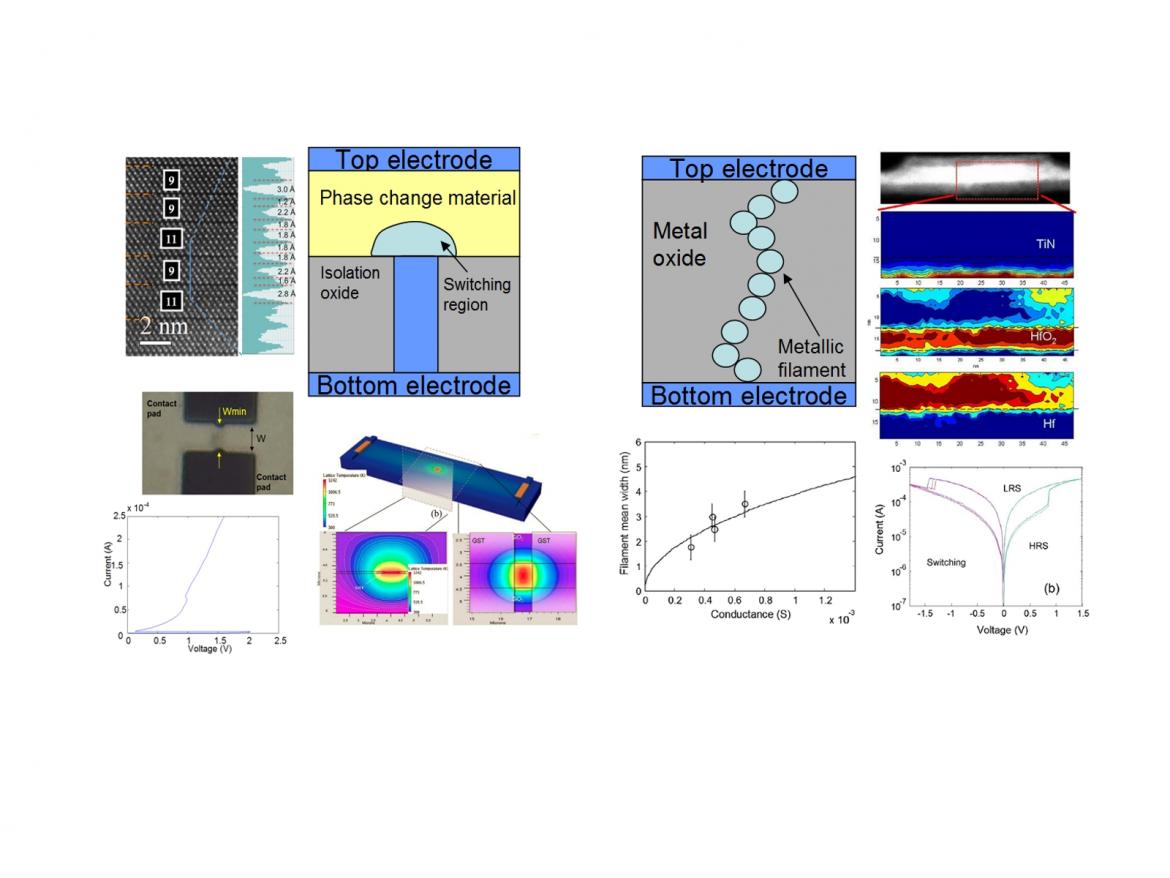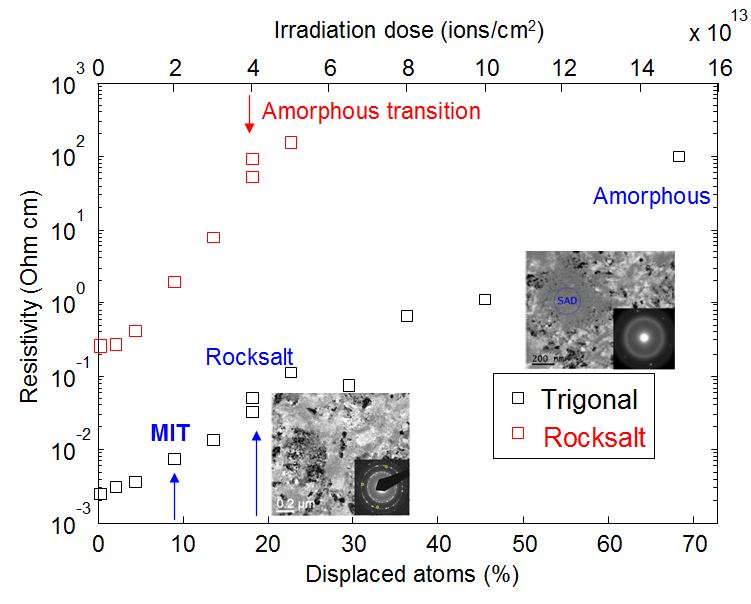
Phase change materials
Phase change materials are interesting candidates for emerging applications in memories, photonics, displays, ovonic threshold switch selectors and non von Neumann computing. We study the structure and the electrical properties of GeSbTe alloys for applications in microelectronics, including memories and trimmable resistors. We have developed a write/read/erase procedure to trim resistors of phase change materials, in order to obtain a desired resistance and temperature coefficient of resistance (TCR). These devices are therefore suitable for reconfigurable high precision resistors.The trimming process employs two electric pulses: a first one for the amorphization of a small region of a resistor, and a second pulse that crystallizes the amorphous into the metastable cubic structure. At the end of the process resistance values larger up to 10-20% of the initial value, with a TCR close to zero, are obtained.
Phase change materials in the crystalline phase have been also recently proposed for multi-bit storage and for the realization of interfacial PCM (iPCM). These would allow lower power consumption and better reliability. Since in this approach the logic states differ for the degree od order, we have studied the stability of the crystalline phases and the kinetics of the transition from the metastable to the stable crystalline structure as a function of disorder. The disorder is introduced into the crystalline films by ion irradiation with Ar ions in diluted cascade. This process is similar to the disordering produced by an electric pulse through melting and quenching and it therefore produces the amorphization of the material. We have therefore investigated the stability of the crystalline structures as a function of ion fluence.

Selected papers and patents
- Metal - Insulator Transition Driven by Vacancy Ordering in GeSbTe Phase Change Materials, V. Bragaglia, F. Arciprete, W. Zhang, A. M. Mio, E. Zallo, K. Perumal, A. Giussani, S. Cecchi, J. E.Boschker, H. Riechert, S. Privitera, E. Rimini, R. Mazzarello and R. Calarco, Scientific Reports, vol 6, 23843 (2016).
- Electrically Trimmable Phase Change GeSbTe Resistors With Tunable Temperature Coefficient of Resistance, S. Privitera, G. D’Arrigo, A. M. Mio, N. Piluso, F. La Via, and E. Rimini, IEEE Trans. Elec. Dev. Vol. 61, pag. 2879 (2014).
- Mixed phase Ge2Sb2Te5 thin films with temperature independent resistivity, S. Privitera, C. Garozzo, A. Alberti, L. Perniola, and B. De Salvo, AIP Advances, vol. 3, 012105 (2013)
- US Patent 8,319,597 B2 Resistor structure of phase change material and trimming method thereof, S. Privitera
-US Patent 8,952,492 B2 High precision resistor and trimming method thereof. S. Privitera, A. Santangelo
- US Patent 9,230,720 B2 Electrically trimmable resistor device and trimming method thereof, A. Santangelo and S. Privitera
Resistive switching memories
For the development of resistive switching memories we have investigated a crossbar memory with size 50x50 nm2 with HfO2 dielectric and have employed the STEM and energy loss spectroscopy to study the structure of the filaments in the low resistance state, after the forming process was completed. The measured filament size has been then correlated to the electrical resistance, obtaining insights on the filament resistivity, composition and nanostructure

Selected papers
- Conductive filament structure in HfO2 resistive switching memory devices, S. Privitera, G. Bersuker, S. Lombardo, C. Bongiorno, D. C. Gilmer, Solid State Electronics, vol. 111, pag. 161 (2015).
-Microscopy study of the conductive filament in HfO2 resistive switching memory devices, S. Privitera, G. Bersuker, B. Butcher, A. Kalantarian, S. Lombardo, C. Bongiorno, R. Geer, D. C. Gilmer, P. D. Kirsch, Microelectronic Engineering, vol. 109, p. 75 (2013).
-Microscopic Model for the Kinetics of the Reset Process in HfO2 RRAM, A. Kalantarian, G. Bersuker, B. Butcher, D. C. Gilmer, S. Privitera, S. Lombardo, R. Geer, Y. Nishi, P. Kirsch, R. Jammy, VLSI Technology, Systems and Applications (VLSI-TSA) 2013 International Symposium on, p. 1 (2013).
Contact: Stefania Privitera


